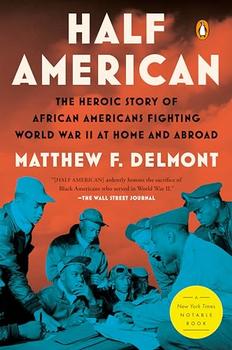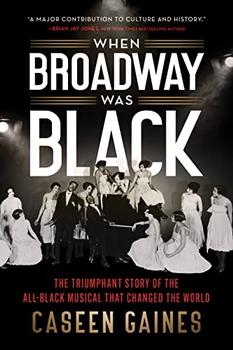Summary | Excerpt | Reviews | Beyond the book | Read-Alikes | Genres & Themes | Author Bio

The Epic Story of African Americans Fighting World War II at Home and Abroad
by Matthew DelmontHalf American: The Epic Story of African Americans Fighting World War II at Home and Abroad is an impeccably researched and deeply moving story of heroes, villains and white supremacy. With World War II as a grand backdrop, author Matthew Delmont weaves a breathless tale of black men who heroically fought for their country, but returned home to inequality, harassment and joblessness. Along the way, he touches on the heroism of black Americans who contributed to the war effort and racial justice while remaining in the United States.
From the get-go, it's a complicated ask from Delmont to the reader: to reorient their World War II empathy away from the victims of Hitler and towards the victims of Jim Crow. Strategically, he begins not with any widely known WWII event but with the black press and their sphere of influence. Black newspapers like the Chicago Defender and the Baltimore Afro-American inspired their readers towards anti-fascism. While it was somewhat in vogue to not fight the "white man's war," the black press promoted their own creation, a "Double V" campaign which signified victory both against inequality at home and against fascism overseas. This movement was motivated in part by around 80 black Americans who volunteered to fight in the Spanish Civil War (1936-1939) on behalf of Spain's Republican government. One such man was Walter Garland, a 23-year-old Army veteran who led white men as a lieutenant.
In the meantime, the U.S. Army refused to integrate its segregated units, curiously saying they were not interested in "sociological experiments." West Point graduate Colonel E. W. Plank declared that black soldiers were "akin to well-meaning but irresponsible children" who could not be "trusted to tell the truth," despite 38,000 black men having served in combat in World War I.
In 1939, President Roosevelt called for an expansion of the U.S. Army Air Corps. When more people were needed to fulfill orders for military equipment and weapons, black labor leader A. Philip Randolph interpreted this as a boon for black workers. But the workforce remained mostly segregated. Black workers continued to be maltreated, dehumanized and denied opportunities at defense plants in Detroit and other Midwestern cities. Randolph organized the March on Washington Movement (MOWM) to exact pressure on President Roosevelt regarding segregation in the military and defense plants. Posters were distributed in pool halls, barber and beauty shops, and corner stores. Randolph envisioned a crowd at the Lincoln Memorial, the same site where a year earlier Marian Anderson sang in front of 75,000 after the Daughters of the American Revolution (DAR) refused her appearance at Constitution Hall. "This is our own, our native land," Randolph said. "We are Americans. We are patriots."
Fearing the estimated 100,000 marchers, Roosevelt signed Executive Order 8802. It forbade discrimination in the defense industry, created job training and established the Fair Employment Practices Committee (FEPC). However, the order made no mention of segregation in the military, and did not address the barbarity black troops were experiencing at the hands of Jim Crow white supremacists. Southern military bases were epicenters of racist savagery and black soldiers were at their breaking point. They experienced harassment on base, and sometimes violence from locals.
Despite not always being recognized at the time, there are many examples of black excellence and brilliance during WWII, perhaps the best known today being the Tuskegee Airmen. Deployed in June of 1943, they were the first black American pilots to fly in combat. Their first mission was an attack on Pantelleria Island, between Tunisia and Sicily. They bombed machine gun sites, escorted bombers on raids, monitored the skies. They dropped bombs marked "1941" (the year of Pearl Harbor) and handwritten messages addressed to Hitler and Mussolini. The first victory for the Tuskegee Airmen was shooting down a Nazi plane on July 2, 1943. Lieutenant Charles Hall recounted, "It was my eighth mission but the first time I had seen the enemy close enough to shoot at him." General Eisenhower remarked, "I would like to meet the pilot who shot down that Jerry!"
Movies have been made about the Tuskegee Airmen; Red Tails comes to mind. But Delmont focuses on many other examples of black people who participated in the war as well. Rosa Parks' brother Sylvester McCauley is mentioned. He fought for four years and still faced discrimination upon return to Alabama. White supremacists like Senator James O. Eastland of Mississippi continually posited the inferiority argument against men like McCauley: "The Negro soldiers have disgraced the flag of their country."
Eastland wasn't an outlier. Black GIs in southern states were denied GI Bill funds. In Mississippi, 86% of skilled and semiskilled jobs given to veterans were given to white veterans. Many black veterans were denied VA loans. Nevertheless, black veterans were resistant to efforts to oppress them after accessing a different level of freedom in the military.
Despite the painful passages in Half American, I appreciated Delmont's scholarship and detail. A quality storyteller, he brings to life a cohort of men and women who are often unseen, shaping them into intimate characters, although reading about their trauma is not cathartic. It left me wondering, what was it all for? They couldn't vote, couldn't use public accommodations, were often jobless once the war ended.
But trees don't all reap fruit in the season they are planted. Liberation can be a slow process when it is a matter of the underprivileged asking to be liberated from racist ideology. Fighting a war, though redemptive, wasn't the cure for racist treatment, but this treatment also didn't subtract from the enormous achievement of stopping Hitler. While it wasn't Double V as the black press intended, World War II was part of the modern emancipation of black people.
![]() This review was originally published in The BookBrowse Review in November 2022, and has been updated for the
January 2024 edition.
Click here to go to this issue.
This review was originally published in The BookBrowse Review in November 2022, and has been updated for the
January 2024 edition.
Click here to go to this issue.

If you liked Half American, try these:

by Kellie Carter Jackson
Published 2025
A radical reframing of the past and present of Black resistance—both nonviolent and violent—to white supremacy.

by Caseen Gaines
Published 2023
The triumphant story of how an all-Black Broadway cast and crew changed musical theatre—and the world—forever.
Your guide toexceptional books
BookBrowse seeks out and recommends the best in contemporary fiction and nonfiction—books that not only engage and entertain but also deepen our understanding of ourselves and the world around us.